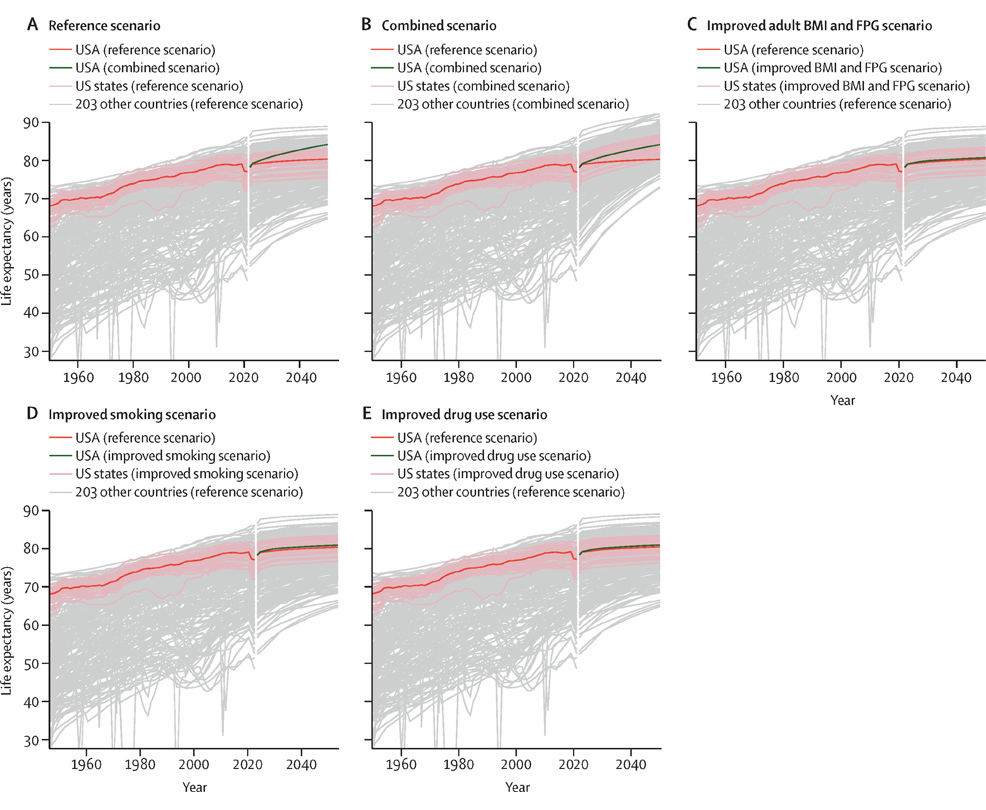
19th December 2024 U.S. life expectancy predicted to stall by 2050 A study in The Lancet finds that life expectancy progress in the United States is slowing. Only modest increases are likely by 2050, as the country falls below nearly all high-income and some middle-income countries in the global rankings.
The U.S. is failing to keep pace with dozens of countries around the world due to a steady decline of the nation's health progress, according to a detailed analysis of all 50 states and Washington, D.C., published this month in The Lancet. Researchers at the Institute for Health Metrics and Evaluation (IHME) produced health estimates and forecasts (the most likely future) of life expectancy, mortality, and morbidity due to more than 350 diseases and injuries and 68 risks in the U.S. from 1990 to 2050. Life expectancy (LE) in the U.S. is forecast to increase from 78.3 in 2022, to 79.9 in 2035, and to 80.4 in 2050 for both sexes combined. This modest increase will significantly lower the country's global ranking – from 49th in 2022, to 66th in 2050 among the 204 countries and territories included in the latest Global Burden of Disease (GBD) study. Mortality rates have declined since 1990 for many leading causes of death, most notably ischemic heart disease, cancer, and stroke. That has contributed to improvements in life expectancy. Despite this progress over the last three decades, the U.S. is predicted to rank progressively lower than other nations globally in the average number of years a person can expect to live in good health. Known as healthy life expectancy or health-adjusted life expectancy (HALE), its global ranking is expected to drop from 80th in 2022, to as low as 108th by 2050.
"In spite of modest increases in life expectancy overall, our models forecast health improvements slowing down due to rising rates of obesity, which is a serious risk factor to many chronic diseases and forecasted to leap to levels never before seen," said Professor Christopher Murray, IHME Director and co‑senior author. "The rise in obesity and overweight rates in the U.S. – with IHME forecasting over 260 million people affected by 2050 – signals a public health crisis of unimaginable scale." Other alarming trends have emerged. From 1990 to 2021, the U.S. recorded an 878% increase in the mortality rate (from 2.0 to 19.5 deaths per 100,000) from drug use disorders, including from opioid use disorder, amphetamine use disorder, cocaine use disorder, and a group of other drug use disorders. The death rate is forecast to climb another 34% between 2022 and 2050 (from 19.9 to 26.7 deaths per 100,000). That is the highest drug use-related mortality rate in the world and more than twice as high as the second-highest country, which is Canada. "The stark contrast that's forecasted in the next 30 years comes after a concerted effort by federal, state, and local government agencies and health systems launched after the opioid crisis was declared a public health emergency in 2017," explained Professor Ali Mokdad from IHME, lead author. "The opioid epidemic is far from over, and greater effectiveness and continued expansion of programs to prevent and treat drug use are still needed." The researchers produced several future scenarios to explore how the U.S. could have less devastating consequences of some health outcomes. If major risk factors like obesity, high blood sugar, and high blood pressure were eliminated by 2050, 12.4 million deaths could be averted in the U.S. That said, if these risk factors were eliminated globally, the health gains wouldn't be enough for the U.S. to improve its global ranking, and it would still fall behind some peer countries. Some countries, like Canada, are so far ahead of the U.S. that life expectancy in the U.S. would only catch up to that of Canada if these risks were only eliminated in the U.S.
However, the scenarios estimate that tackling one risk factor can still save millions of lives. For example, if smoking alone were reduced across the U.S. to the level of the lowest smoking rates, the nation could have 2.1 million fewer deaths by 2050. If the country were successful in lowering high body mass index levels and high blood sugar levels during the same three decades, it could prevent 1.4 million people from dying. "The rapid decline of the U.S. in global rankings from 2022 to 2050 rings the alarm for immediate action. The U.S. must change course and find new and better health strategies and policies that slow down the decline in future health outcomes," said co-senior author Dr. Stein Emil Vollset, Affiliate Professor from IHME. "Poor health harms the economy because the nation suffers from a reduced workforce, lower productivity, and higher health care costs for companies and their employees. That leads to a lower GDP and a chance for peer countries with a stronger economy to overtake the U.S., creating a ripple effect around the world financially and geopolitically," said Dr. Murray. Improving access to preventive medical care is critical for early detection and disease management, says the IHME. Early intervention can also reduce complications and lower health care costs. Previous studies have also suggested that the higher the level of education people achieve, the lower the risk of dying, because more schooling leads to less risk-taking and better-informed decisions. However, local leaders still need to invest their time and money in community health where disparities can be better addressed through personalised care and customised community programs. "All Americans must have access to high-quality health care through universal health coverage to prevent illness, stay healthy, and be protected from financial hardship regardless of their income," said Dr. Mokdad.
Comments »
If you enjoyed this article, please consider sharing it:
|
||||||









